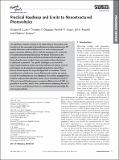| dc.contributor.author | Lunt, Richard R. | |
| dc.contributor.author | Rowehl, Jill A. | |
| dc.contributor.author | Osedach, Timothy Paul | |
| dc.contributor.author | Brown, Patrick Richard | |
| dc.contributor.author | Bulovic, Vladimir | |
| dc.date.accessioned | 2013-08-26T20:59:19Z | |
| dc.date.available | 2013-08-26T20:59:19Z | |
| dc.date.issued | 2011-11 | |
| dc.date.submitted | 2011-09 | |
| dc.identifier.issn | 09359648 | |
| dc.identifier.issn | 1521-4095 | |
| dc.identifier.uri | http://hdl.handle.net/1721.1/80286 | |
| dc.description.abstract | The significant research interest in the engineering of photovoltaic (PV) structures at the nanoscale is directed toward enabling reductions in PV module fabrication and installation costs as well as improving cell power conversion efficiency (PCE). With the emergence of a multitude of nanostructured photovoltaic (nano-PV) device architectures, the question has arisen of where both the practical and the fundamental limits of performance reside in these new systems. Here, the former is addressed a posteriori. The specific challenges associated with improving the electrical power conversion efficiency of various nano-PV technologies are discussed and several approaches to reduce their thermal losses beyond the single bandgap limit are reviewed. Critical considerations related to the module lifetime and cost that are unique to nano-PV architectures are also addressed. The analysis suggests that a practical single-junction laboratory power conversion efficiency limit of 17% and a two-cell tandem power conversion efficiency limit of 24% are possible for nano-PVs, which, when combined with operating lifetimes of 10 to 15 years, could position them as a transformational technology for solar energy markets. | en_US |
| dc.description.sponsorship | Eni-MIT Alliance Solar Frontiers Program (Eni S.p.A. (Firm)) | en_US |
| dc.description.sponsorship | National Science Foundation (U.S.). Graduate Research Fellowship Program | en_US |
| dc.description.sponsorship | Link Foundation | en_US |
| dc.description.sponsorship | Hertz Foundation (Fellowship) | en_US |
| dc.language.iso | en_US | |
| dc.publisher | Wiley Blackwell | en_US |
| dc.relation.isversionof | http://dx.doi.org/10.1002/adma.201103404 | en_US |
| dc.rights | Creative Commons Attribution-Noncommercial-Share Alike 3.0 | en_US |
| dc.rights.uri | http://creativecommons.org/licenses/by-nc-sa/3.0/ | en_US |
| dc.source | Bulovic via Amy Stout | en_US |
| dc.title | Practical Roadmap and Limits to Nanostructured Photovoltaics | en_US |
| dc.type | Article | en_US |
| dc.identifier.citation | Lunt, Richard R., Timothy P. Osedach, Patrick R. Brown, Jill A. Rowehl, and Vladimir Bulović. “Practical Roadmap and Limits to Nanostructured Photovoltaics.” Advanced Materials 23, no. 48 (December 22, 2011): 5712-5727. | en_US |
| dc.contributor.department | Massachusetts Institute of Technology. Department of Electrical Engineering and Computer Science | en_US |
| dc.contributor.department | Massachusetts Institute of Technology. Department of Materials Science and Engineering | en_US |
| dc.contributor.department | Massachusetts Institute of Technology. Department of Physics | en_US |
| dc.contributor.department | Massachusetts Institute of Technology. Microsystems Technology Laboratories | en_US |
| dc.contributor.approver | Bulovic, Vladimir | en_US |
| dc.contributor.mitauthor | Osedach, Timothy Paul | en_US |
| dc.contributor.mitauthor | Brown, Patrick Richard | en_US |
| dc.contributor.mitauthor | Bulovic, Vladimir | en_US |
| dc.contributor.mitauthor | Lunt, Richard R. | en_US |
| dc.contributor.mitauthor | Rowehl, Jill A. | en_US |
| dc.relation.journal | Advanced Materials | en_US |
| dc.eprint.version | Author's final manuscript | en_US |
| dc.type.uri | http://purl.org/eprint/type/JournalArticle | en_US |
| eprint.status | http://purl.org/eprint/status/PeerReviewed | en_US |
| dspace.orderedauthors | Lunt, Richard R.; Osedach, Timothy P.; Brown, Patrick R.; Rowehl, Jill A.; Bulović, Vladimir | en_US |
| dc.identifier.orcid | https://orcid.org/0000-0002-0960-2580 | |
| dc.identifier.orcid | https://orcid.org/0000-0001-7388-2815 | |
| mit.license | OPEN_ACCESS_POLICY | en_US |
| mit.metadata.status | Complete | |
